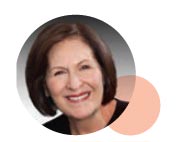Lou-Ellen Barkan
President & CEO

In 1982, 11-year-old Jeremy Abbate’s mom told him not to be surprised if Grandpa didn’t remember his name. She was hopeful, she told her son, that scientists would find a treatment for Alzheimer’s soon. Fast forward 35 years and Mr. Abbate, now Publisher and Vice President of Scientific American magazine, is saying the same things to his kids.
In a compelling essay, “With Every Alzheimer’s Diagnosis, the Same Bleak Conversation,” published in The Wall Street Journal in late August, Mr. Abbate laments, “Researchers have made so many breakthroughs in fighting disease over the past century that progress can seem inevitable. Ailments that once were death sentences — diabetes, HIV/AIDS, many forms of cancer — have been transformed into chronic but manageable conditions. But for Alzheimer’s, as the old phrase goes, we got nothing.”
I too have been perplexed by the inability of the research community to make faster progress in finding a cure for a disease that, today, directly impacts the lives of over five million Americans and is on track to affect five times that many in the not too distant future.
As a layperson, I cannot and will not criticize the many dedicated and brilliant scientists who are working tirelessly trying to unlock the mystery of this disease. But, as Mr. Maine, my high school science teacher reminded us, science is about formulating and testing hypotheses. It’s about figuring out if something works and if those results can be replicated. And if they cannot, you either amend your hypothesis or try something entirely different.
For the past 30 years or so, Alzheimer’s research, primarily funded through the National Institutes of Health (NIH), has largely focused on whether amyloid beta or tau protein is the key driver of Alzheimer’s. But after decades of little progress in finding effective therapies to slow the progression of the disease or cure it, I think Mr. Maine would agree that it’s time to branch out in new directions. And scientists are doing just that, working together to share information and resources. There is renewed interest in the link between Alzheimer’s and microbes, viruses and other pathogens. And researchers are taking a reinvigorated look at the relationship of brain inflammation to the disease and the role of lifestyle and diet.
This is all very encouraging, but we are very far behind, and the aging community is growing exponentially. What can we do now to support the many families and individuals affected by a dementia diagnosis today and the many more quickly coming down the road?
First, we can ensure that caregivers have the resources they need to provide good care while they take care of themselves and their families. At CaringKind, we know that the most effective therapy for Alzheimer’s and related dementias is good care. And good care is provided one-on-one by caregivers — mostly family members, mostly women, mostly people who are dropping everything, including giving up economic and other opportunities, to take care of someone they love, or someone they don’t necessarily love.
Caregivers make extraordinary sacrifices, and we must make them our priority. And at CaringKind, they are. We support them with programs, services, and resources that they cannot get anywhere else. Until the day when we have effective treatments and a cure, CaringKind will be here, thanks to the community’s support, implementing innovative, creative and leading-edge caregiving initiatives, and providing an unprecedented platform of programs that help caregivers care with confidence.
P.S. Please see our Year-End letter highlights some of the terrific things we’ve been doing over the last year. Please support us so we can continue to expand and reach out to all who need us!
Sincerely,

